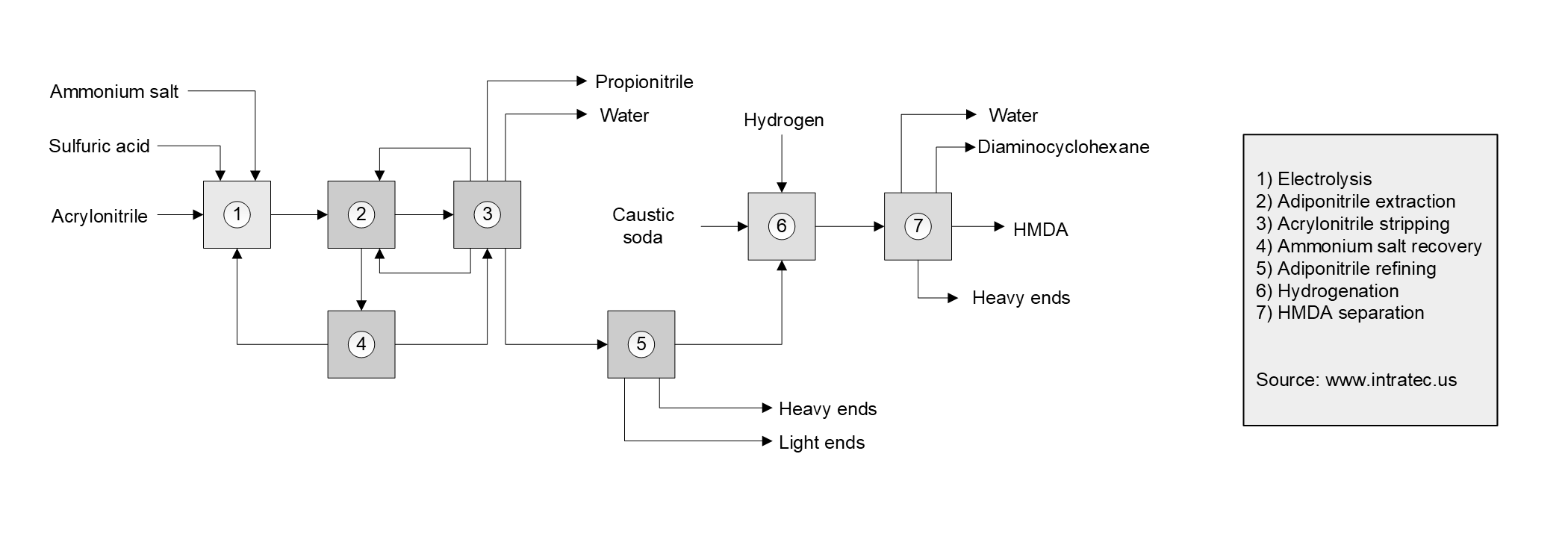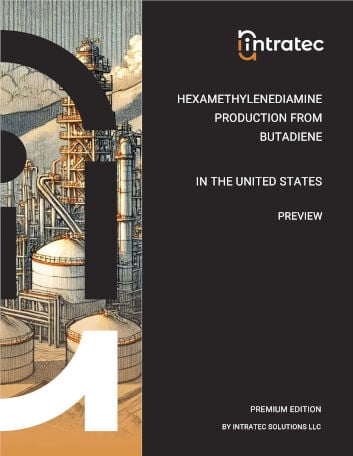Commodity Production Costs Report
Hexamethylenediamine Production from Acrylonitrile
Hexamethylenediamine Plant Capital & Operating Cost Analysis | United States | Q2 2025
This report presents the economics of Hexamethylenediamine (HMDA) production from acrylonitrile. The process examined is similar to the one developed by Monsanto. In this process, adiponitrile intermediate is initially generated from electrodimerization of acrylonitrile. Subsequently, the adiponitrile is hydrogenated to produce HMDA.
The report provides a comprehensive study of Hexamethylenediamine production and related Hexamethylenediamine production cost, covering three key aspects: a complete description of the Hexamethylenediamine production process examined; an in-depth analysis of the related Hexamethylenediamine plant capital cost (Capex); and an evaluation of the respective Hexamethylenediamine plant operating costs (Opex).
The Hexamethylenediamine production process description includes a block flow diagram (BFD), an overview of the industrial site installations, detailing both the process unit and the necessary infrastructure, process consumption figures and comprehensive process flow diagrams (PFD). The Hexamethylenediamine plant capital cost analysis breaks down the Capex by plant cost (i.e., ISBL, OSBL and Contingency); owner's cost; working capital; and costs incurred during industrial plant commissioning and start-up. The Hexamethylenediamine plant operating costs analysis covers operating expenses, including variable costs like raw materials and utilities, and fixed costs such as maintenance, labor, and depreciation.

The process under analysis comprises four major sections: (1) Electrodymerization; (2) Adiponitrile Separation; (3) Hydrogenation; and (4) HMDA Purification
Electrodymerization. Acrylonitrile and water are fed to an electrolyzer, in the form of a filter press, with polypropylene blocks containing lead anodes and lead-silver alloy cathodes on opposite sides. The acrylonitrile is submitted to electrodimerization in such electrolytic cells, in which the catholyte and the anolyte are separated by a cation-permeable membrane so that adiponitrile intermediate is produced. A dilute aqueous sulfuric acid, used as anolyte, is circulated through the anolyte compartment. The catholyte consists of acrylonitrile, adiponitrile, quaternary ammonium aromatic sulfonate (QAS), and water. The oxygen formed is released from the circulating anolyte, while a fraction of the liquid flowing in the cathode part, containing the adiponitrile formed, is withdrawn, and directed to separation and purification steps downstream.
Adiponitrile Separation. The cathode effluent containing the adiponitrile is passed through extractors for the removal of residual acrylonitrile and quaternary ammonium aromatic sulfonate, which are further purified and recycled. After the extraction, four distillation steps follow to remove residual acrylonitrile, light and heavy impurities. Purified adiponitrile is routed to the hydrogenation section.
Hydrogenation. Adiponitrile, fresh and recycle hydrogen are fed to a “gas-lift” reactor, where they quickly react on the surface of RaneyTM nickel catalysts yielding Hexamethylenediamine (HMDA). High catalyst concentrations are used to keep the concentration of unreacted nitriles very low. Water and caustic soda are fed to the reactor so as to make up for losses leaving in the crude HMDA.
HDMA Purification. Crude HMDA is passed through a distillation train, so as to remove water, 1,2-diaminocyclohexane (DCH) and high boilers. DCH is still sent to a column, in which residual HDMA is recovered, before it is purged.
Report in PDF Format
Download & Explore Anytime
Access in Various Devices
Print & Read Comfortably
Share With Co-workers
Up-to-date Report
Professional report based on Q2 2025 economic data, ensuring timely evaluations.
Multiple Use Cases
Ideal for investment screening, feasibility studies, cost estimates, and research planning.
Proven Methodology
Developed using a consistent methodology honed over a decade, ensuring reliable cost analyses.
Report Editions
Content Highlights
Plant Capital Cost Summary
Summary outlining the capital cost required for building the Hexamethylenediamine production plant examined.
Plant Capital Cost Details
Detailing of fixed capital (ISBL, OSBL & Owner’s Cost), working capital and additional capital requirements.
Plant Cost Breakdowns
Breakdown of Hexamethylenediamine process unit (ISBL) costs and infrastructure (OSBL) costs; plant cost breakdown per discipline.
Operating Costs Summary
Summary presenting the operating variable costs and the total operating cost of the Hexamethylenediamine production plant studied.
Operating Cost Details
Detailing of utilities costs, operating fixed costs and depreciation.
Plant Capacity Assessment
Comparative analysis of capital investment and operating costs for different Hexamethylenediamine plant capacities.
Production Process Information
Block Flow Diagram, descriptions of process unit (ISBL) and site infrastructure (OSBL).
Process Consumptions
Raw materials and utilities consumption figures, by-products credits, labor requirements
Process Diagrams
Process flow diagrams (PFD), equipment list and industrial site configuration
Other Hexamethylenediamine Production Cost Reports

Hexamethylenediamine Production from Adipic Acid
This report presents the economics of Hexamethylenediamine (HMDA) production from adipic acid. In the process examined, adipic acid is reacted with ammonia, forming ammonium adipate and adipamide, which are then dehydrated to adiponitrile intermediate. The adiponitrile is finally hydrogenated to HMDA. The economic analysis performed assumes a plant located in the United States.
Details: 200 kta United States-based plant | Q2 2025 | 107 pages | Issue B | From $1,199 USD

Hexamethylenediamine Production from Adiponitrile
This report presents the economics of Hexamethylenediamine (HMDA) production from adiponitrile. In the process examined, adiponitrile is hydrogenated to HMDA. The economic analysis is based on a plant constructed in the United States.
Details: 200 kta United States-based plant | Q2 2025 | 107 pages | Issue D | From $999 USD

Hexamethylenediamine Production from Butadiene
This report presents the economics of Hexamethylenediamine (HMDA) production from butadiene. In the process examined, butadiene is reacted with hydrogen cyanide to generate adiponitrile intermediate, which is then hydrogenated to HMDA. The economic analysis performed assumes a plant located in the United States.
Details: 200 kta United States-based plant | Q2 2025 | 107 pages | Issue A | From $1,199 USD
Bundle & Save
Purchase multiple Hexamethylenediamine Production Cost reports and enjoy tiered discounts
up to 30% off!
Could Not Find the Report You Need?
Obtain a Bespoke Report
Get a report targeting the process in which you are interested
See Offer Details
Understand Bespoke Reports and how you can easily order them
Check Editions & Pricing
Complete a brief form and see a quotation for your Bespoke Report
Other Related Production Cost Reports

Acrylonitrile Production from Propane
This study presents the economics of Acrylonitrile production via propane ammoxidation. The process is similar to the one proposed by PTT Asahi Chemical (PTTAC), consisting in the reaction of propane with ammonia, producing Acrylonitrile. Acetonitrile and hydrogen cyanide are produced as by-products. The analysis assumes a plant located in the United States,
Details: 200 kta United States-based plant | Q2 2025 | 107 pages | Issue B | From $799 USD

Hydrogen Production from Natural Gas (Partial Oxidation Process)
This study provides a techno-economic study of Hydrogen production from natural gas in the United States. In this analysis, natural gas is submitted to a thermal partial oxidation process, producing syngas, which is passed through a shift converter to enrich the Hydrogen output.
Details: 25 MM Nm3/y United States-based plant | Q2 2025 | 107 pages | Issue C | From $799 USD

Nylon 6, 6 Production from Adipic Acid & HMDA (Continuous Process)
This report presents the economics of Nylon 6,6 production from adipic acid and hexamethylenediamine (HMDA) via formation of hexamethylene diamonium adipate salt in the United States. The process analyzed consists of a continuous polycondensation process.
Details: 120 kta United States-based plant | Q2 2025 | 107 pages | Issue B | From $799 USD

Hexamethylene Diisocyanate from HMDA (Non-Phosgene Process)
This report presents a techno-economic analysis of Hexamethylene Diisocyanate (HDI) production from hexamethylene diamine (HMDA) in the United States. The process presented in this report is a non-phosgene process similar to BASF process. Initially, HMDA reacts with urea and butanol generating a carbamate intermediate. Then, the carbamate is thermally cracked producing HDI.
Details: 20 kta United States-based plant | Q2 2025 | 107 pages | Issue B | From $799 USD

Advanced Natural Gas Combined Cycle Power Plant
This study also provides a techno-economic analysis about Electricity generation from natural gas in the USA. In this study, high efficiency H-class combustion turbines (CT) supplemented with heat recovery steam generators (HRSG) and steam turbines (ST) are employed to Electricity generation.
Details: 3500 GWh/y United States-based plant | Q2 2025 | 107 pages | Issue D | From

Acrylonitrile Production from Propylene (Fluidized Bed Ammoxidation)
This report presents the economics of Acrylonitrile production from chemical grade (CG) propylene in the United States. The process reviewed is a propylene ammoxidation technology using fluidized bed reactor, in which propylene reacts with ammonia, producing Acrylonitrile, and generating acetonitrile and hydrogen cyanide as by-products.
Details: 300 kta United States-based plant | Q2 2025 | 107 pages | Issue A | From $799 USD

Hydrogen Production from Natural Gas (Steam Reforming)
This report provides an economic analysis of Hydrogen production from natural gas in the United States using a steam reforming process. Initially, methane present in natural gas is cracked with steam generating syngas. Then, the carbon monoxide from syngas is reacted with steam, producing carbon dioxide and additional hydrogen.
Details: 1000 MM Nm3/y United States-based plant | Q2 2025 | 107 pages | Issue A | From $799 USD

Conventional Natural Gas Combined Cycle Power Plant
This report examines the costs associated to Electricity generation from natural gas in the USA via conventional natural gas combined cycle. In this process F-class combustion turbines (CT) supplemented with heat recovery steam generators (HRSG) and steam turbines (ST) are employed to Electricity generation.
Details: 5200 GWh/y United States-based plant | Q2 2025 | 107 pages | Issue C | From
+800 Reports Developed, Targeting +250 Commodities
Vast Report Library
858 independent and up-to-date reports examining embryonic and established production processes.
Free Sample Reports
Quickly understand the structure and depth of content of our professional reports.

